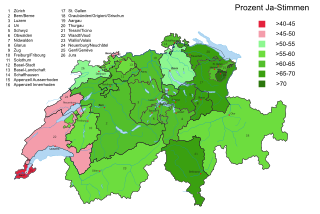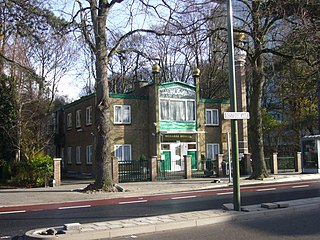
A mosque, also called a masjid, is a place of worship for Muslims. The term usually refers to a covered building, but can be any place where Islamic prayers are performed, such as an outdoor courtyard.

Islam is the second largest religion in the Netherlands, after Christianity, and is practised by 5% of the population according to 2018 estimates. The majority of Muslims in the Netherlands belong to the Sunni denomination. Many reside in the country's four major cities: Amsterdam, Rotterdam, The Hague and Utrecht.

The history of the Jews in the Netherlands largely dates to the late 16th century and 17th century, when Sephardic Jews from Portugal and Spain began to settle in Amsterdam and a few other Dutch cities, because the Netherlands was an unusual center of religious tolerance. Since Portuguese Jews had not lived under rabbinic authority for decades, the first generation of those embracing their ancestral religion had to be formally instructed in Jewish belief and practice. This contrasts with Ashkenazi Jews from central Europe, who, although persecuted, lived in organized communities. Seventeenth-century Amsterdam was referred to as the "Dutch Jerusalem" for its importance as a center of Jewish life. In the mid 17th century, Ashkenazi Jews from central and eastern Europe migrated. Both groups migrated for reasons of religious liberty, to escape persecution, now able to live openly as Jews in separate organized, autonomous Jewish communities under rabbinic authority. They were also drawn by the economic opportunities in the Netherlands, a major hub in world trade.

The history of the Jews in Indonesia began with the arrival of early European explorers and settlers, and the first Jews arrived in the 17th century. Most Indonesian Jews arrived from Southern Europe, the United Kingdom, the Netherlands, Belgium, Germany, France, the Middle East, North Africa, India, China, and Latin America. Jews in Indonesia presently form a very small Jewish community of about 500–1,000, from a nadir of about 20 in 1997. Judaism is not recognized as one of the country's six major religions, however its practices are allowed under Perpres 1965 No. 1 and article 29 paragraph 2 of the Constitution of Indonesia. Therefore, members of the local Jewish community have to choose to register as "Belief in One Almighty God" or another recognized religions on their official identity cards.

Moorish Revival or Neo-Moorish is one of the exotic revival architectural styles that were adopted by architects of Europe and the Americas in the wake of Romanticist Orientalism. It reached the height of its popularity after the mid-19th century, part of a widening vocabulary of articulated decorative ornament drawn from historical sources beyond familiar classical and Gothic modes. Neo-Moorish architecture drew on elements from classic Moorish architecture and, as a result, from the wider Islamic architecture.

The conversion of non-Islamic places of worship into mosques occurred during the life of Muhammad and continued during subsequent Islamic conquests and invasions and under historical Muslim rule. Hindu temples, Jain Temples, churches, synagogues, and Zoroastrian fire temples have been converted into mosques.

The Synagogue of Santa María la Blanca, also known as the Ibn Shoshan Synagogue, is a former Jewish congregation and synagogue, located at 4 Calle Reyes Católicos, in the historic old city of Toledo, in the province of Castilla-La Mancha, Spain. Erected in the late twelfth or early thirteenth century, it is disputably considered the oldest synagogue building in Europe still standing. The building was converted to a Catholic church in the early 15th century.

The Nederlands Verbond voor Progressief Jodendom is the umbrella organisation for Progressive Jews in the Netherlands, and is affiliated to the World Union for Progressive Judaism. It was founded in 1931.

Karaköy, the modern name for the old Galata, is a commercial quarter in the Beyoğlu district of Istanbul, Turkey, located at the northern part of the Golden Horn mouth on the European side of Bosphorus.

The Delft Synagogue is a Reconstructionist Jewish congregation and synagogue, located at Koornmarkt 12, in the city of Delft, in the South Holland region of The Netherlands. Designed by L. Winkel in the Neoclassical style, the synagogue was completed in 1862, fell into disuse after World War II, was subsequently restored and reconsecrated from 1974.

The federal popular initiative "against the construction of minarets" was a successful popular initiative in Switzerland to prevent the construction of minarets on mosques. In a November 2009 referendum, a constitutional amendment banning the construction of new minarets was approved by 57.5% of the participating voters. Only three of the twenty Swiss cantons and one half canton, mostly in the French-speaking part of Switzerland, opposed the initiative.

The Mubarak Mosque in The Hague is the first purpose-built mosque in the Netherlands. Its foundation stone was laid by Sir Muhammad Zafarullah Khan on 20 May 1955 who later inaugurated the mosque on 9 December 1955.

The Neveh Shalom Synagogue is a Reform Jewish congregation and synagogue, located in Paramaribo, Suriname. The congregation was established as an Orthodox community who worshipped in the Ashkenazi rite.

The al-Muallak Mosque also known as the Mosque of Zahir al-Umar is a mosque in Acre, Israel.

Brick Lane Mosque or Brick Lane Jamme Masjid, formerly known as the London Jamme Masjid, is a Muslim place of worship in Central London and is in the East End of London.

The Bet Israel Synagogue, also known as the Beit Israel Synagogue, is a Jewish congregation and synagogue located at 265 Mithatpaşa Street, in the Turgut Reis neighbourhood, in the Karataş quarter of the city of İzmir, in the İzmir Province of Turkey. The synagogue was completed in 1907 and is the largest synagogue in the city, the other major synagogue being the Shaar Hashamaym Synagogue.
Islam is the majority and official religion in the United Arab Emirates, professed by 74.5% of the population as of 2020. 63.3% are Sunni, 6.7% are Shia, while 4.4% follow another branch of Islam. The Al Nahyan and Al Maktoum ruling families adhere to the Maliki school of jurisprudence. Many followers of the Hanbali school are found in Sharjah, Umm al-Quwain, Ras al-Khaimah and Ajman. Their followers include the Al Qasimi ruling family. The other main religions present in the country include Christianity (12.9%), Hinduism (6.2%), and Buddhism (3.2%). Zoroastrians, Druze, Baha'i, Judaism, and Sikhism are also practiced by some non-nationals. 1.3% of the population is agnostic.

The Great Synagogue of Deventer is a former Jewish congregation and synagogue, located at Golstraat 23, in the city of Deventer, in the Overijssel region of The Netherlands. Designed by J. A. Mulock Houwer in a mix of the Renaissance Revival and Moorish Revival styles, the synagogue was completed in 1892.

The Surabaya Synagogue, officially the Beth Shalom Synagogue, was a former Jewish congregation and synagogue, located in Surabaya, Java, Indonesia. It is generally said to have been the only synagogue in the country during the years it operated, although since then Sha'ar Hashamayim has opened in Sulawesi.

The Sidna Omar Mosque is a Mamluk-era mosque in the Jewish Quarter of the Old City of Jerusalem. It stands adjacent to the Hurva and Ramban Synagogues.
























